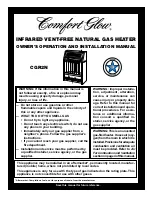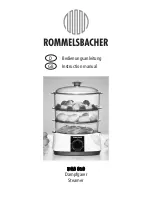
8
2) Fixing the comfort temperature :
The comfort temperature is the temperature that you would like while the room is occupied.
a) Set the cursor
A
to
, the light
V3
comes on.
b) Adjust knob
C
to 5, the heating light
V1
comes on if the ambient temperature is below the required temperature.
c) Wait for a few hours until the temperature stabilizes.
d) If you are happy with the setting (
use a thermometer to check if you wish
) mark the position once and for all.
Otherwise, modify the setting and return to item c).
3) Adjusting the Eco temperature :
This involves a reduction in degrees compared to the Comfort temperature. We recommend that you use this mode for periods
of absence of more than 2 hours or overnight.
Warning: This reduction applies to the Comfort temperature so it is important to set the Comfort temperature first, before setting
the Eco reduction.
a) Set cursor
A
to
, indicator light
V2
lights up.
b) It is recommended to turn the dial fully to the right, to show the thinnest end of the black line. This sets the temperature 10°C
below the selected Comfort level. The -3.5°C in the middle of the line is not a room temperature but a reference point if you wish
to set an intermediate reduction. The indicator light
V1
comes on if the room temperature drops below the selected Eco level.
c) Wait for a few hours until the temperature stabilizes.
d) If you are happy with the setting (
use a thermometer to check if you wish
) mark the position once and for all.
Otherwise, modify the setting and return to item c).
NB: The measurement is set to –3.5°C in our laboratories. It is possible that the setting for the reduction is not precisely –3.5°C,
depending on your installation’s particular characteristics. In this case, adapt the setting to obtain the desired reduction.
4) Frost free :
This mode keeps the temperature at about 7°C in the room when the house is unoccupied for a long period (
usually more than 24
hours
).
a) Set the cursor
A
to
.
5) The heating light :V1
This light indicates periods during which the resistance is heating.
6) Stop heating
Move the cursor to
.
7) Locking the controls
It is possible to lock or limit the range of use of thumb-wheels
B
to
C
and lock selector
switch cursor
A
to prevent the inadvertent manipulation of the device (
by children, etc
).
a) Detach the device from its wall bracket.
b) On the back of the thermostat box, detach pins
P
from their supports.
c) Choose position
N
to lock the thumb-wheels or position
L
to limit the range of use of
the thumb-wheels.
Choose one of the positions
M
to lock the person in the desired mode.
8) Programming mode
This device has a thermostat capable of receiving orders through its pilot wire. It recognizes the following commands:
- CONFORT (comfort)
: Temperature set using the thumb-wheel
C
- CONFORT –1 (comfort –1) : Temperature set using the thumb-wheel
C
: -1°C
- CONFORT -2 (comfort –2) : Temperature set using the thumb-wheel
C
: -2°C
- ECO
: Temperature set using the thumb-wheel
B
.
- HORS GEL (frost-free)
: Room temperature maintained at approximately 7°C
- STOP HEATING
: Immediate stoppage of the heater (
used for load-schedding
).
To activate the programming mode set cursor
A
to
.
In this way, by connecting the pilot wire to a timer, you can program your Comfort and Economy temperature periods. It is possible
to connect several devices to one timer and, in this way, make energy savings.
NB: When there is no command given over the pilot wire, the device heats in the Comfort mode. HG and load-shedding commands
override the Economy and Comfort modes. On changing from the Comfort mode to the Economy mode, the changeover time is
approximately 12 seconds.
A
B
C
N










































